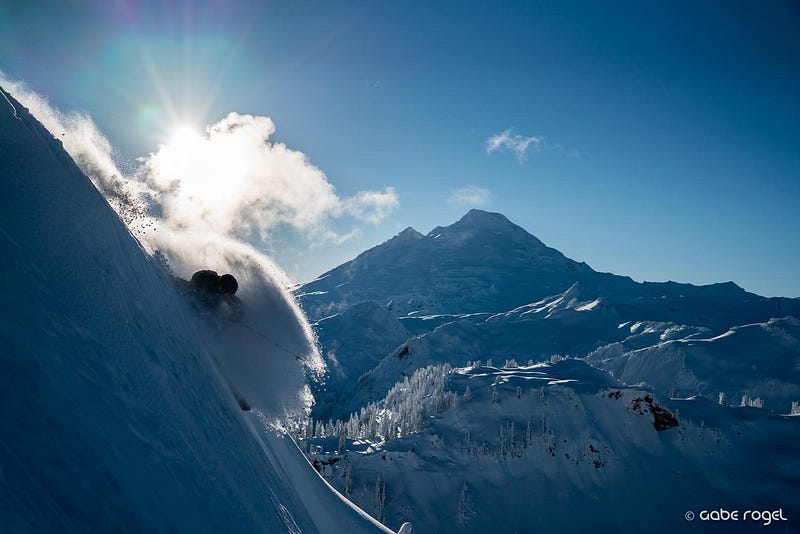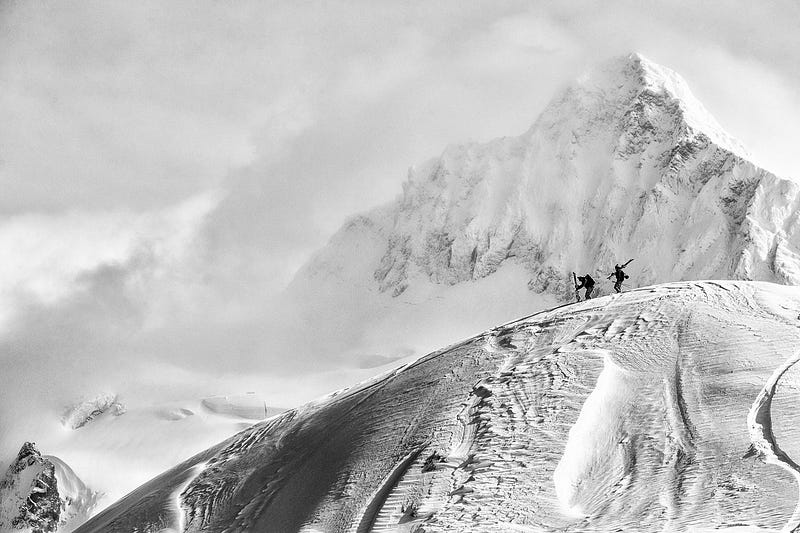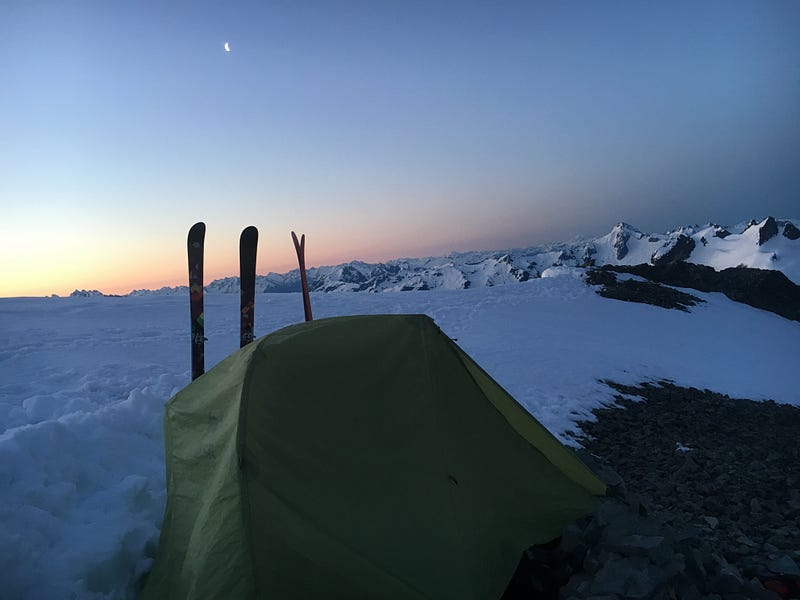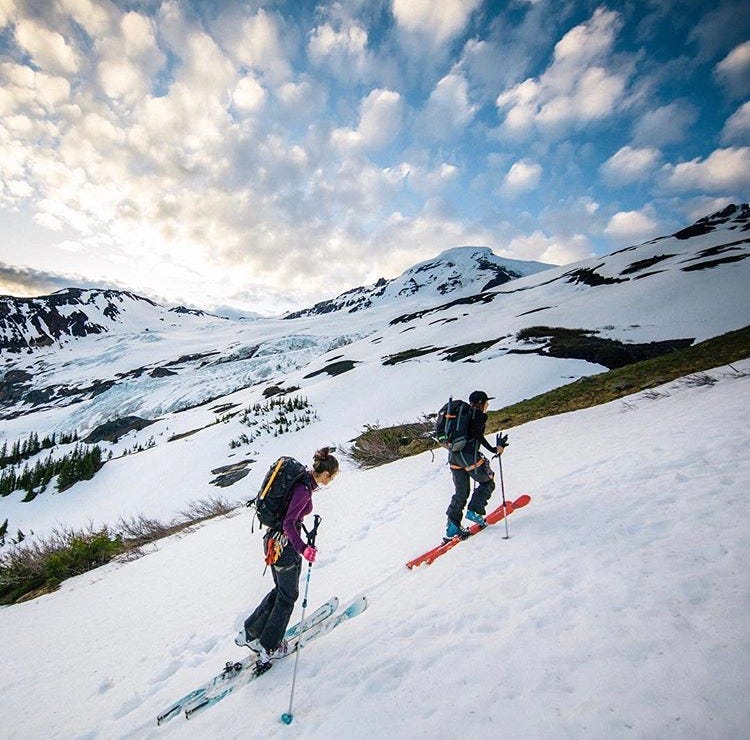Skiing On The Edge Of Danger
Skiers risk their lives to descend down untouched snow
Story by ELITSA YANEVA | Photos by SOPHIA ROUCHES, GABE VOGEL & GRANT GUNDERSON

As they strap on their touring skis and duck below the red rope with an “Avalanche Warning” sign informing them of the risks ahead, skiers push the boundaries of Mother Nature in pursuit of untouched snow.
The Mount Baker wilderness provides a playground for daring backcountry skiers as they spend their winters avoiding lift lines and creating white lines behind them.
A winter wonderland of fresh white flakes layering the mountains, asks to be sprayed by the fast turns of a downhill skier.
Backcountry skiing consists of anything outside of a designated ski area and is away from quick medical help. Unlike inbounds skiing, backcountry provides the solitude and satisfaction of knowing you will be the first to ride down the face of a mountain with fresh snow received the night before.
Lee Lazzara has backcountry skied for 24 years. For the last four years, he has led people on wilderness adventures through the North Cascades as a backcountry guide for Baker Mountain Guides.
Backcountry guides are individuals whose jobs are to lead people safely up and down the mountain. Introduction to backcountry courses are offered in the Mount Baker wilderness to safely bring people into the sport with an emphasis on risk education.
“When you are going into the backcountry, you are just going into the mountain in the winter. The resort is the anomaly,” said Lazzara.
When backcountry skiing, it’s crucial to be prepared. Essential equipment typically consists of a shovel, beacon for location purposes, and a skiing partner. Skiers attach strips of microfiber fabric along the bottom of the ski, called skins, essential to ensure they can hike without sliding down the mountain.

“The whole concept of ski touring is a really cool dynamic you are able to bring into backcountry skiing,” said Sophia Rouches, a 21-year-old backcountry skier. “When you are walking uphill, you are able to look at what you are going to ski down. It gives you an interesting perspective to be like ‘I want to hit that cliff’ or ‘I want to ski this line.’”
The night before, skiers huddle around a map of the Mount Baker wilderness, determine an objective and calculate how long traveling will take up the mountain. Timing is an important aspect because changing weather conditions can alter the stability of the snow throughout the day.
Parked next to a 10-foot-tall snow bank, an all-wheel drive SUV resembles a clown car as skiers, snowboarders and mounds of equipment suddenly eject from the vehicle. The group rushes to dress in light layers and goggles, sliding into gear.
The group hikes uphill for four hours, before reaching their destination point, where they remove their skins before making the much-desired ride down.
“I think that the really cool part about skinning is that you can get in this really meditative state because you’re going uphill for hours on end, it doesn’t feel like it,” Rouches said. “It flies by and all of a sudden you’re on the top of your line.”
While backcountry skiing safety is of utmost concern. Having a reliable partner and both people must be confident in their ability to assess risks and make good decisions is paramount.

“Essentially when your backcountry skiing, your life is in somebody else’s hands and that is something that gets overlooked a lot in the sport,” Rouches said. “When you’re transitioning to skiing from inbounds to outbounds, it’s really easy to not make those connections and not think about that. When you’re in the backcountry, ski patrol is not out there to help you. No one else is really there to save you.”
Groups of backcountry skiers need to eliminate anticipated human factor issues by making sure everyone has similar goals, compatible fitness levels and communicate effectively as a team. Skiers also need to be confident in their abilities to assess the terrain and avoid any area with avalanche risk.
Mitigating hazards is done through analyzing terrain, Lazzara said. Avalanches are triggered by either a natural or human cause, steep terrain and unstable snow.
“It doesn’t take a patch of snow bigger than six by six feet to sweep you off your feet and take you down the mountain in high consequence terrain,” Lazzara said.
In the case of an avalanche, injury or lost skier, a call is made to 911, where dispatch determines the direction of the call. The search and rescue deputy is contacted to assess the type of emergency further. The call goes to Bellingham Mountain Rescue Council, one of the Whatcom County’s nine search and rescue groups that specializes in mountain rescue. A text message is then sent out to all 45 volunteer members describing the case and within the half-hour, a group leaves town on a mission to bring the skiers home.
Eric Beamer, 60, has volunteered in mountain rescue for 10 years. Beamer utilizes experience he gained as a Mountain Search and Rescue Council board member and 20 years of backcountry skiing experience as tools to help him save lives.
“The worst combination for backcountry safety is somebody who is really skilled at downhill skiing or snowboarding in the ski area — they are just very athletic and super confident with good skiing — but they don’t understand mountain terrain and avalanches,” Beamer said. “Everything that looks fun when you are a really good skier is dangerous. If it doesn’t look fun, it’s not dangerous. Avalanche terrain is the fun terrain so it is super easy to stumble into trouble when you are a good skier.”

Beamer finds satisfaction in his volunteer work, knowing that he is able to save lives and help those in need of assistance in the mountains he loves.
When search and rescue make contact with a reporting party, they ask questions to find out what the lost or injured person was doing, when they were supposed to be back, what equipment they had and other information that may help.
“There is that emotional pull of ‘I want to find that person’ or ‘I think that they are right over here but I know I shouldn’t do it because it is unsafe but I think I can do it,’” Beamer said. “You have to rein those in and be safe.”
Whatcom County Search and Rescue receives a dozen to 30 or more calls a year. So far this year, there haven’t been many missions in the winter but the missions that have occurred have lasted multiple days, Beamer said.
Beamer recommends skiers take at least one formal avalanche class and recognize all the hazards in an area including deep snow emersion, moats, crevasses, walking off a cornice and hypothermia. The more educated one is on nature’s mountain features, wilderness first aid and navigation the more likely you will be to make it home safe.
“It’s amazing what the body can endure when you set your mind to not quitting on surviving,”
Beamer said. “We’ve found people alive when the textbooks say they in all probability would be dead after many nights in the backcountry simply because they refused to give in.”
In the occurrence of an avalanche, a buried victim has 15 minutes until suffocation. Thus, for avalanche accidents in the backcountry, individuals and their team must be self-reliant. When Mountain Rescue gets involved, it is usually for body recovery.
A friend of Beamer’s unfortunately died on Mount Baker, which served as the inspiration for him to get involved in search and rescue.

“We met the Mountain Rescue people that responded later and that’s when I found out I have the same skills that they did, if not more than some of them in that area. That’s when I knew I could help,” Beamer said.
One of the best resources that search and rescue has is the use of a helicopter to bring the reported individual out of the mountains and for medical help. Unfortunately, Whatcom County does not have a helicopter, so one must be used from another location. Helicopters are only permitted for a mission if a life or limb is threatened, otherwise the rescue team must reach victims by foot.
Rouches talks about a time search and rescue had to send a helicopter to bring home her injured friend from the backcountry during one of their long ski trips. Her group had been skiing around the Washington pass area during a sunny spring day when her friend jumped off a feature that had a rocky landing and tumbled down, resulting in a compound fracture in his elbow. Rouches was right behind him and quick to action, using her wilderness first aid training to help the injury and regulate his body temperature while two people from their group of eight skinned back to an area with cell phone reception. They waited four to five hours before the helicopter came.
“I think that was a big moment for me when I realized the importance of training and preparation on how to respond to those situations,” Rouches said. “You have to be more cautious in your skiing and understanding the points of when you are committed to a line and don’t have cell service, what the process is when shit goes wrong.”
